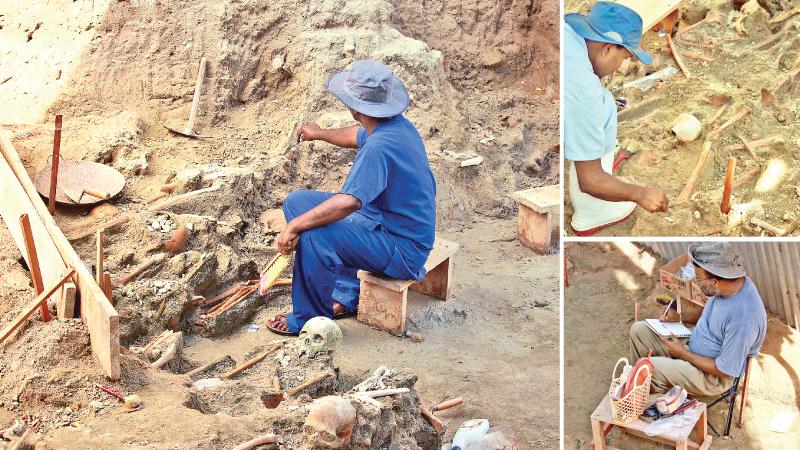
As excavations into the alleged mass grave under the CWE (Sathosa) building in Mannar continue under a scorching sun, experts warn that carbon dating alone may not tell the full story of the bones. After our comprehensive report on the suspected mass grave last month, Sunday Observer reporters returned to the excavation site last week
Mannar District Judicial Medical Officer (JMO) Dr Saminda Rajapaksha labours using miniscule tools to excavate skeletal remains discovered under the CWE Sathosa building in the town of Mannar earlier this year. He is joined by Forensic Archaeologist Prof. Raj Somadeva, who is busy observing small bones and meticulously recording notes and diagrams about each new piece of the large puzzle. Both Dr Rajapaksha and Prof Somadeva have been at this task for nearly four months now, with no end in sight. And four months in, the margins of the suspected mass grave site are yet to be determined. In the blazing heat of a dry zone afternoon, the scientists plod on.
 Under the circumstances, one can’t help but wonder if it would be more useful to send bone samples for carbon dating and decide on whether to continue the investigation based on the results of that test. But Dr Rajapaksha, who is the Chief Investigator of the suspected mass grave site, explains that carbon dating alone will not answer all the questions pertaining to the burials. “Carbon dating tests only establish the absolute date of a bone,” he explained, “it does not reveal the history of the bone, whether it was buried directly at this site, or if it was buried elsewhere and then transported here.”
Under the circumstances, one can’t help but wonder if it would be more useful to send bone samples for carbon dating and decide on whether to continue the investigation based on the results of that test. But Dr Rajapaksha, who is the Chief Investigator of the suspected mass grave site, explains that carbon dating alone will not answer all the questions pertaining to the burials. “Carbon dating tests only establish the absolute date of a bone,” he explained, “it does not reveal the history of the bone, whether it was buried directly at this site, or if it was buried elsewhere and then transported here.”
The Chief Investigator explains that only investigations at the excavation site will reveal if these bones had travelled. “Such bones will contain traces of dirt and soil from the original burial site, and that will give us a clue,” he said.
Only a final report by all those involved in the forensic examination will piece together the story of how the grave site had come about, Dr Rajapaksha explained. “We can’t totally depend on carbon dating – that is only one test that will give us a piece of the puzzle by telling us the age of the bones,” he added.
Currently, the grave site is still in the excavation stage. The next stage will be analysis. Investigators will present their conclusion on the mass grave site only after a complete analysis, through a final report.
Only the Mannar Magistrate can grant persons outside of the team of investigators permission to visit the site. Journalists are permitted to visit on any work day, at stipulated times of the day in order to prevent disturbance of the excavation process. Dr. Rajapaksha commenting on security measures and limitations enforced on visitors to the mass grave told the Sunday Observer, “If someone for some reason, intentionally or unintentionally leaves even a small object at the excavation site; or if anything falls into the dig we cannot ignore it. It is our mandate to investigate everything inside the dig.
By chance, if such an incident happens, it could even change the direction of the investigation. That’s why visitors are being limited, otherwise we have no objections to people observing our work because we want to be totally transparent,” he said.
Many of those involved in the ‘dig’ are volunteers. Most engage in the mass grave excavation in the midst of performing other important duties attached to their regular positions. Dr Rajapaksha for instance is the only JMO in the Mannar District. During lunch hour at the excavation site, Dr Rajapaksha rushes into the Office of the JMO to attend to his other tasks. When he has to leave the district for official duty, including providing witness accounts in courts, investigations at the grave site under the Sathosa must be halted.
Recently when duties outside of the district called him away, and the excavation was temporarily halted, false news reports began to circulate that the investigation had been concluded, Dr Rajapaksha told the Sunday Observer. In fact, excavation is halted when he is called away in order to ensure accountability and integrity of the investigation of the suspected mass grave site, in keeping with his responsibilities as chief investigator. As of Wednesday, September 19, the investigations at the mass grave site at the CWE premises in Mannar had completed its 74th day. Investigators had identified 137 complete skeletons out of which 131 had been excavated and stored at the Magistrate’s Court premises.
Investigators say, the fact that the skeletons are layered, one on top of the other similar to tiles laid on a roof, slows down the digging process. In addition to human bones, from time to time the dig had yielded small items, not clearly identified but presumed to be rings the Chief Investigator noted.
